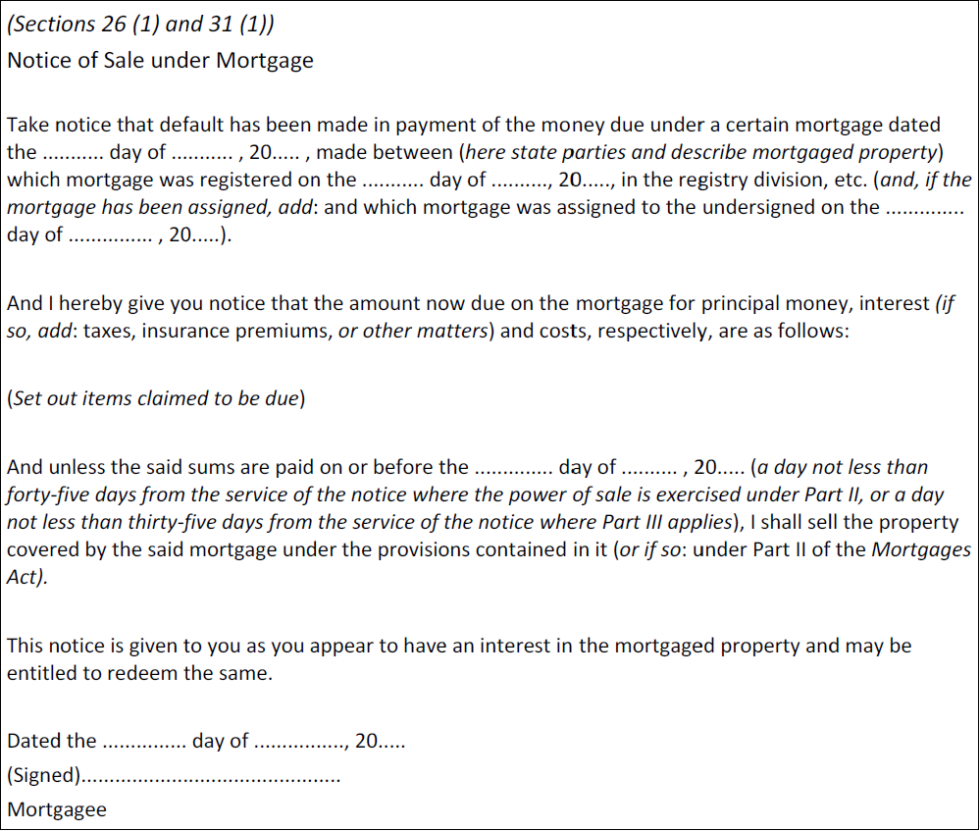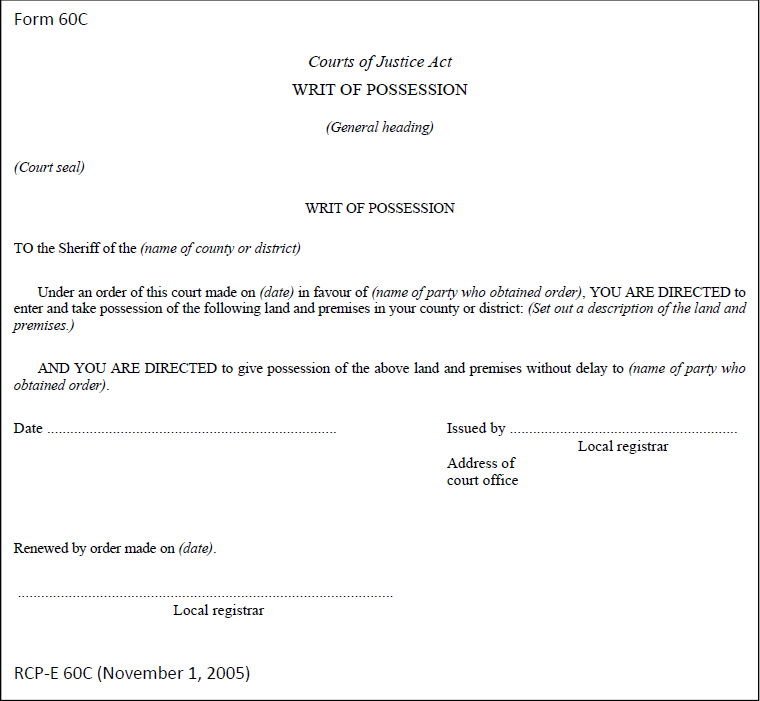A Power of Sale is the most common mortgage remedy used by mortgagees of land in Ontario. When a borrower fails to uphold the terms of the mortgage, a Power of Sale can be used to recover the lender’s principal, interest and expenses. The lender must follow a strict process in order to follow through with the eviction of the mortgagor and the eventual sale of the property.
The Power of Sale Timeline in Ontario
Step 1: The Borrower Defaults on the Mortgage
Step 2: The Lender Delivers a Notice of Sale and Related Notices
The lender must wait at least 15 days after the default to deliver a Notice of Sale Under Mortgage. There is also a requirement to give notice under the Bankruptcy Act and the Farm Debt Mediation Act, the latter two notices being mailed to the mortgagor in advance of delivery of the Notice of Sale.
The content of the Notice of Sale and to whom it must be mailed is governed by provisions of the Mortgages Act. It is mailed by prepaid registered mail to every party shown as a mortgagor and guarantor, as well as to all other parties who have an interest in the mortgaged property. These would include subsequent mortgagees, any persons with liens registered against the property, and execution creditors. After the Notice of Sale is mailed, the lender must wait 35 days (or 40 days if the property is occupied by a married couple) before taking any further steps.

Step 3: The Borrower is Given Time to Pay Off the Mortgage Debt
The waiting period after the Notice of Sale is delivered is referred to as the redemption period. During this time, the borrower must either bring the mortgage into good standing if it is not due or pay off the entire mortgage debt, including legal fees incurred by the lender to enforce their rights.
If the mortgagor does not pay what is owed prior to the expiry of the redemption period, the lender is able to issue a Statement of Claim for the collection of the debt owed and for possession of the property. With the eviction of the mortgagor and others living at the property, the lender can follow the approved practices, which will allow them to list the property for sale on MLS.
Step 4: The Lender Applies to Take Possession of the Property

Step 5: The Lender Evicts the Homeowners and Takes Possession of the Property
Step 6: The Property is Sold, and the Proceeds From the Sale Are Used to Pay Off Debts
When the sale is completed and the money is received, the proceeds of the sale are paid out in the following order:
- The expenses incurred by the lender in selling the property are paid first. This includes the real estate agent’s fee, the real estate lawyer’s fees, and other related fees and expenses.
- Payment of the lender’s principal and interest and other sums to which the lender is entitled are next to be paid from the proceeds of the sale.
- If any funds are left over after the previous payments then payment is made to subsequent mortgagees, lien claimants and execution creditors in the priority in which they were registered until the funds are exhausted.
- Any remaining money after all other parties have been paid must go to the former homeowner.
Often, the costs associated with conducting the Power of Sale process are such that the homeowner will receive little to no proceeds from the sale of the property. In addition, if the mortgage lender is unable to fully recover their entire investment principal, they can file a Writ of Execution for the remaining sum owed with the local sheriff.
Important Legal Notice
Always remember that the above discussion about the Power of Sale process is for informational purposes only and is not an exhaustive discussion of the entire process available to a mortgage lender in the face of a mortgagor’s default. Any lender who is experiencing a mortgage default should seek legal advice as to how they should proceed. In addition, the borrower has rights in the face of a Power of Sale and should consult a lawyer when they receive a Notice of Sale Under Mortgage.
Need Power of Sale advice?
Speak with us, and we’ll connect you directly with a Power of Sale lawyer you need. We’ve got you covered. Call 647-931-5396 or email ron@mortgagebrokerstore.com and gain expert advice!
Discover more about deed in lieu of foreclosure by clicking here. And more about strict foreclosure here.
Stop Power of Sale and Foreclosure in Cities & Towns Across Ontario, Including:
- Stop Ajax Power of Sale
- Stop Aurora Power of Sale
- Stop Barrie Power of Sale
- Stop Belleville Power of Sale
- Stop Bradford Power of Sale
- Stop Brampton Power of Sale
- Stop Brant Power of Sale
- Stop Brantford Power of Sale
- Stop Burlington Power of Sale
- Stop Caledon Power of Sale
- Stop Cambridge Power of Sale
- Stop Chatham Power of Sale
- Stop Cobourg Power of Sale
- Stop Cornwall Power of Sale
- Stop Fergus Power of Sale
- Stop Fort Erie Power of Sale
- Stop Georgina Power of Sale
- Stop Guelph Power of Sale
- Stop Halton Hills Power of Sale
- Stop Hamilton Power of Sale
- Stop Innisfil Power of Sale
- Stop Kingston Power of Sale
- Stop Kitchener Power of Sale
- Stop Lindsay Power of Sale
- Stop London Power of Sale
- Stop Markham Power of Sale
- Stop Milton Power of Sale
- Stop Mississauga Power of Sale
- Stop Newmarket Power of Sale
- Stop Niagara Falls Power of Sale
- Stop North Bay Power of Sale
- Stop Oakville Power of Sale
- Stop Orangeville Power of Sale
- Stop Orillia Power of Sale
- Stop Oshawa Power of Sale
- Stop Ottawa Power of Sale
- Stop Peterborough Power of Sale
- Stop Pickering Power of Sale
- Stop Port Hope Power of Sale
- Stop Richmond Hill Power of Sale
- Stop Sarnia Power of Sale
- Stop Sault Ste. Marie Power of Sale
- Stop Scarborough Power of Sale
- Stop St. Catharines Power of Sale
- Stop St. Thomas Power of Sale
- Stop Stouffville Power of Sale
- Stop Stratford Power of Sale
- Stop Sudbury Power of Sale
- Stop Thunder Bay Power of Sale
- Stop Timmins Power of Sale
- Stop Toronto Power of Sale
- Stop Uxbridge Power of Sale
- Stop Vaughan Power of Sale
- Stop Waterloo Power of Sale
- Stop Welland Power of Sale
- Stop Whitby Power of Sale
- Stop Windsor Power of Sale
- Stop Woodstock Power of Sale